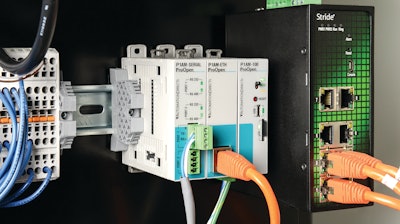
Although it seems that almost every electronic device on the market is either Ethernet or Wi-Fi capable, there are plenty of commercial and industrial components that continue to use long-established serial RS232/RS485 communications, sometimes exclusively. Some may have a perception that serial comms are “old tech,” but in reality they are straightforward, inexpensive, and more than sufficient for a wide range of applications (Figure 1).
 Figure 1: The AutomationDirect ProductivityOpen platform, with expandable Ethernet, serial, and I/O modules, is a flexible way for users to apply open-source computing to industrial-grade serial/Ethernet communications and controls applications.AutomationDirect
Figure 1: The AutomationDirect ProductivityOpen platform, with expandable Ethernet, serial, and I/O modules, is a flexible way for users to apply open-source computing to industrial-grade serial/Ethernet communications and controls applications.AutomationDirect
While many automation components work in a largely standalone manner, most devices need more connectivity capabilities as they gain intelligence because there is an increasing need to communicate with other plant devices for configuration/setup, diagnostics, and data transport. Often the data volume and speed are not too demanding, so serial communications are the best option for connecting one or more devices to a main host for aggregating data, and possibly transmitting it to higher-level systems.
A hobby- or consumer-grade single board controller is one way to perform this data aggregation task. However, many user applications must run reliably for years in relatively harsh environments, where a light-duty product simply will not perform, or even survive. For these cases, there is now an option for combining open-source computing and serial/Ethernet communications in a compact and industrial-grade package, for little more expense than a basic controller.
Opening Industrial Communications
For developers creating a small control system, an automated piece of equipment, or a consumer-facing kiosk, there is often a compelling need to integrate multiple intelligent digital devices for monitoring and control. Some examples of these devices are:
- Variable frequency drives (VFDs)
- PID loop controllers
- Barcode scanners
- Lighting controllers
Each of these devices can be procured with built-in Ethernet, or add-on networking modules. However, the additional equipment expense and networking installation sometimes simply isn’t warranted. Most of these devices are available natively with RS232/RS485 using Modbus RTU or other protocols, and this can be the best-fit communications solution. RS232 is generally point-to-point (host-to-device), but RS485 is particularly attractive because it is multi-drop (host to many devices). Installation is simple, with just a two-conductor shielded cable daisy-chained through the devices.
The next question is how to integrate multiple serial devices to report the data and otherwise interface with higher-level systems.
Over the past 20 years, the availability and capability of consumer-grade digital devices and software have accelerated. Many hobbyist “makers” are familiar with developing “homebrew” projects using these devices to great effect, especially with leading microcontrollers such as the Raspberry Pi and Arduino.
The Arduino is particularly attractive because even though it is relatively bare-bones and low in cost, it is quite capable, and a number of stackable accessory boards called shields can be added for Ethernet, Wi-Fi, and other functions. Unfortunately, a basic Arduino is decidedly more of a prototyping and hobbyist product.
Fortunately, an industrial-grade version of Arduino is now available from AutomationDirect, namely its ProductivityOpen Controller, with all the accessories and option modules needed to make robust serial data aggregation applications a reality. The brains of the product are a MKRZero Arduino, built into a rugged housing and certified to meet UL and other standards. It can accept some open-source and do-it-yourself shields, but it really shines by offering industrialized power supply, wired input/output modules, Ethernet, and serial communications shields.
A Typical Application
To see where industrial open-source makes sense, consider a small microbrewery using numerous basic PID temperature controllers. The brewers would like to log temperature and setpoint data, and to receive notifications for alarm conditions. One option would be to upgrade all the temperature controllers to more capable units.
A more cost-effective and simpler approach is installing an industrial Arduino and associated serial communications and Ethernet shields, and then wire it using RS485 to the temperature controllers. The Arduino can be configured using open C++ code within the integrated development environment, taking advantage of code snippets for this purpose, obtained via GitHub. Or, the developer can use the free graphical block diagram environment to save time using drag-and-drop blocks for the most common functions (Figure 2).
 Figure 2: Developers can use standard C++ code, or the free ProductivityBlocks graphical programming interface, to create their applications.AutomationDirect
Figure 2: Developers can use standard C++ code, or the free ProductivityBlocks graphical programming interface, to create their applications.AutomationDirect
With this platform, the microcontroller can poll each of the temperature controllers for the required data, consolidate the information and perform any needed calculations, and then send the results to the cloud over Ethernet via MQTT for data logging and alarming. The price for this complete hardware setup is around $200, which is more than hobbyist-grade products might cost. However, the resulting platform is clearly industrial-grade, and backed by an industry leading manufacturer with rapid online order fulfillment.
Even as digital devices become smarter and more capable, opportunities will remain to stick with proven technologies such as serial communications to deliver reliable performance using a cost-effective approach. Using an industrial-grade Arduino with serial communications is one example where systems designers and OEMs can strike a balance between using traditional technologies and delivering robust, modern solutions.
About the Author
Chris Kregoski is a product engineer at AutomationDirect in Cumming, GA., on the Productivity PLC development and support team. He spent nearly a decade as the owner of Woodwest Controls, a small system integrator, servicing start-ups in malting, brewing, distilling, and water treatment industries.























